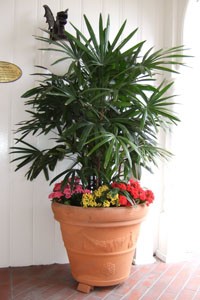
What are the elements of good potting soil?
The next time you add more potting soil to the plants in your accounts, you may be wondering what all those granules you see in the soil are? Here’s a quick and simple guide to the beneficial elements found in good potting soil.
Perlite: What is that white stuff in the soil? It looks like somebody ground up Styrofoam peanuts into tiny pieces. This is perlite. Perlite is a sterile, lightweight material made by heating crushed lava. In a very hot furnace (1400 degrees F.), the water stored in the lava changes to pressurized steam, expanding the particles into little white pellets. They are less than a 1/8″ across and weigh almost nothing. Perlite is added to interior mixes of soil to give it the ability to hold water and promote good aeration at the same time. It contains no nutrients, is sterilized, and has a neutral pH. You will often see it in pothos plants and at first glance, it can look like mealybugs on the soil surface.
Perlite makes plants feel lighter than normal for their pot size and can make you think they are dry if you use the lifting method to see if the plant needs water.
Cinder: Speaking of lava, did you know that all those plants that come from Hawaii are grown in cinder soil? That’s what makes them so heavy. This is a soil-less sterilized volcanic mix unique to Hawaii. It’s quite porous with ½” chunks of very black cinders. Water travels through it quickly and will be reabsorbed from the saucer into the roots if left. Hawaiian soils do need extra fertilizer to keep plants growing well. Dracaenas grow quite well in these soils and produce good strong roots. Give them a bit more water than you would the same varieties in standard mixtures.
Vermiculite: Here is something else you may discover in your quest for knowledge about potting soil. Vermiculite is a mica-like material from Montana or N. Carolina. Sometimes added to interior soils for insulation, it’s spongy in texture and light brown in color. It looks like little chips of cork in the soil. It’s lightweight, has good drainage and has moderate water-holding capacity. The down side of vermiculite is that it compresses over time and can decrease drainage with age. Most interiorscape growers don’t use it any more. Next time you impulse buy a plant at a discount store look to see if you spot vermiculite in the mix.
Now that you have more knowledge about what’s in potting soil, you will understand how these elements benefit your plants.
